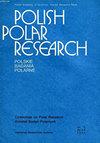基岩形态、轴向搬运和侧向物质来源对辫状河沉积物的影响——以斯匹次卑尔根中部穆宁河谷为例
IF 0.8
4区 地球科学
Q4 ECOLOGY
引用次数: 1
摘要
穆宁河(斯瓦尔巴群岛)是一条多山的辫状前冰川河。它从两个山谷冰川流出,形成一个细长的河道带,在进入主河之前变成一个宽阔的辫状扇。木宁河的轴向水头由冰川提供物质,沿河则由侧向物质供应,即辫状冲积扇、泥石流扇和以河流为主导的扇。对碎屑圆度的详细分析表明,圆度与河道带宽度和河道弯度呈显著负相关,变化幅度较大。穆宁河(斯瓦尔巴群岛)是一条多山的辫状前冰川河。它从两个山谷冰川流出,形成一个细长的河道带,在进入主河之前变成一个宽阔的辫状扇。木宁河的轴向水头由冰川提供物质,沿河则由侧向物质供应,即辫状冲积扇、泥石流扇和以河流为主导的扇。对碎屑圆度的详细分析表明,圆度与河道带宽度和河道弯度呈显著负相关,变化幅度较大。在基岩峡谷中,沟道带宽度小、弯曲度低的断面,圆度增大较快。而在沟道带宽度大、弯度高的断面,圆度变化不大。河道带的形态变化受流域基岩形态的控制,是影响木宁河碎屑圆度的主要因素。侧向物质来源的性质和下游的牵引作用对单个砾石组分的影响较大。在基岩峡谷中。而在沟道带宽度大、弯度高的断面,圆度变化不大。河道带的形态变化受流域基岩形态的控制,是影响木宁河碎屑圆度的主要因素。侧向物质来源的性质和下游的牵引作用对单个砾石组分的影响较大。本文章由计算机程序翻译,如有差异,请以英文原文为准。
Effect of bedrock morphology, axial transport and lateral material sources on braided river sediments: A case study from Munin Valley, central Spitsbergen
The Munin River (Svalbard) is a mountainous braided proglacial river. It drains from two valley glaciers developing an elongated channel belt and turning into a wide braided outwash fan before entering the main river. The Munin River is in its axial head supplied by the material from glaciers, and along the stream by material from lateral sources, i.e. braided outwash fan, debris-flow and fluvial-flow dominated fans. Detailed analyses of clast roundness showed that roundness suddenly changes to higher degrees in negative correlation with channel belt width and sinuosity of the channels. The Munin River (Svalbard) is a mountainous braided proglacial river. It drains from two valley glaciers developing an elongated channel belt and turning into a wide braided outwash fan before entering the main river. The Munin River is in its axial head supplied by the material from glaciers, and along the stream by material from lateral sources, i.e. braided outwash fan, debris-flow and fluvial-flow dominated fans. Detailed analyses of clast roundness showed that roundness suddenly changes to higher degrees in negative correlation with channel belt width and sinuosity of the channels. The roundness increases rapidly in sections with small channel belt width and low sinuosity, which can be seen in the bedrock gorge. On the contrary, the roundness does not change much in sections with large channel belt width and high sinuosity. The morphological changes of the channel belt are controlled by the bedrock morphology of the catchment, which is the main factor affecting the clast roundness in the Munin River. The nature of the lateral material sources and the downstream traction affect rather the individual gravel fractions.be seen in the bedrock gorge. On the contrary, the roundness does not change much in sections with large channel belt width and high sinuosity. The morphological changes of the channel belt are controlled by the bedrock morphology of the catchment, which is the main factor affecting the clast roundness in the Munin River. The nature of the lateral material sources and the downstream traction affect rather the individual gravel fractions.
求助全文
通过发布文献求助,成功后即可免费获取论文全文。
去求助
来源期刊

Polish Polar Research
ECOLOGY-GEOSCIENCES, MULTIDISCIPLINARY
CiteScore
2.00
自引率
7.70%
发文量
0
审稿时长
>12 weeks
期刊介绍:
The quarterly Polish Polar Research edited by the Committee on Polar Research of the Polish Academy of Sciences is an international journal publishing original research articles presenting the results of studies carried out in polar regions.
All papers are peer-reviewed and published in English.
The Editorial Advisory Board includes renowned scientist from Poland and from abroad.
 求助内容:
求助内容: 应助结果提醒方式:
应助结果提醒方式:


